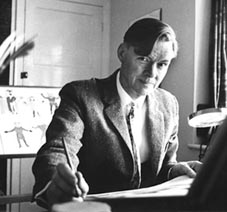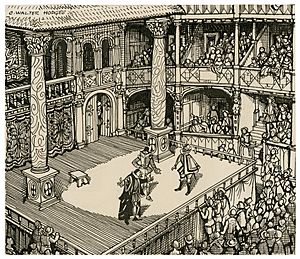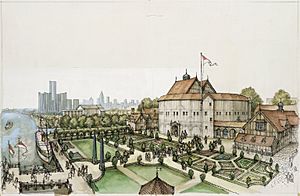C. Walter Hodges facts for kids
Cyril Walter Hodges (born March 18, 1909 – died November 26, 2004) was a talented English artist and writer. He is famous for drawing pictures in children's books. He also helped us understand and imagine what Elizabethan theatres were like. In 1964, he won the important Greenaway Medal for his amazing book illustrations.
Contents
About Walter Hodges' Career
Cyril Walter Hodges was born in Beckenham, Kent. His father, Cyril Hodges, worked in advertising. Walter went to Dulwich College and then studied art at Goldsmiths' College of Art. In 1936, he married Greta Becker, who was a ballet dancer. She supported him throughout his life.
Working as an Illustrator
Walter Hodges spent most of his career as a freelance artist. This means he worked for himself and took on different projects. For many years, he drew pictures for the Radio Times magazine. He also created the cover for their 1938 Christmas edition.
He worked with many famous children's authors. He illustrated books for Ian Serraillier, Rosemary Sutcliff (like The Eagle of the Ninth), Rhoda Power (Redcap Runs Away), Elizabeth Goudge (The Little White Horse), and William Mayne.
Becoming an Author
Hodges spent a year in New York. There, he was encouraged to write his own books, not just illustrate them. His first book was Columbus Sails (1939). It was a historical fiction story for children. This means it was a made-up story set in a real historical time.
Columbus Sails became very popular in both America and England. Its success led him to write more historical books. These included The Namesake: A Story Of King Alfred and its follow-up, The Marsh King. He also wrote Magna Carta, The Norman Conquest, and The Spanish Armada.
The Namesake was a runner-up for the Carnegie Medal. This award celebrates the best British children's book of the year.
Walter Hodges and Theatre
Walter Hodges loved theatre. He designed costumes and scenery for several theatres. These included the Everyman Theatre, Liverpool and the Mermaid Theatre in London. His passion for theatre made him an expert on how the Globe and other theatres from Shakespeare's time were built.
Books About Theatre
From 1935 to 1999, Hodges wrote and illustrated five books about theatre from Shakespeare's era. He spent 30 years studying theatre before writing Shakespeare's Theatre for children. This book was published in 1964 by Oxford University Press.
For Shakespeare's Theatre, he won the annual Kate Greenaway Medal. This award is given by the Library Association for the best children's book illustration by a British artist. Shakespeare's Theatre explained how old festivals and plays grew into professional theatres like the Globe. It also showed and described Shakespeare's famous Globe Theatre, which has now been rebuilt.
Hodges believed that theatre is very important. He said it helps people understand how to behave and what is right or wrong. He thought theatre helps us imagine things about ourselves and others. These imaginings can even become real facts in life. Because of this, he felt theatre is a powerful part of human history.
The Detroit Globe Project
Because Hodges knew so much about Shakespearean theatre, he was invited to Detroit in the late 1970s. A professor named Leonard Leone wanted to rebuild the Globe Theatre there. Hodges helped with the plans. However, the city faced money problems, and the project stopped in 1982.
In 1986, Hodges sold almost 900 of his theatre drawings to the Folger Shakespeare Library. This library now shares these drawings online. They are available for everyone to use and enjoy under a Creative Commons license.
Selected Works by Walter Hodges
Books Written by Walter Hodges
- The Globe Restored: A Study of the Elizabethan Theatre (1935)
- Columbus Sails (1939)
- Shakespeare and the Players (1948)
- Shakespeare's Theatre (1964)
- The Namesake: A Story of King Alfred (1964)
- Magna Carta (1966)
- The Norman Conquest (1966)
- The Marsh King: A Story of King Alfred (1967, a sequel to The Namesake)
- The Spanish Armada (1967)
- The Overland Launch (1969, about a famous lifeboat event in 1899)
- Shakespeare's Second Globe: The Missing Monument (1973)
- The Battlement Garden: Britain from the Wars of the Roses to the Age of Shakespeare (1979)
- Enter the Whole Army: A Pictorial Study of Shakespearean Staging, 1576–1616 (1999)
Books Illustrated by Walter Hodges
- Margaret J. Baker, Hannibal and the Bears (1964)
- Robert Browning, The Pied Piper of Hamelin (1971)
- Elizabeth Goudge, The Little White Horse (1946)
- Alfred Duggan, Growing Up in Thirteenth-Century England (1962)
- Ruth Manning-Sanders, Red Indian Folk and Fairy Tales (1960)
- Rosemary Sutcliff; The Chronicles of Robin Hood (1950)
- Rosemary Sutcliff; The Queen Elizabeth Story (1950)
- Rosemary Sutcliff; The Armourer's House (1951)
- Rosemary Sutcliff; Brother Dusty-Feet (1952)
- Rosemary Sutcliff; The Eagle of the Ninth (1954)
- Rosemary Sutcliff; The Shield Ring (1957)
- Mark Twain, Huckleberry Finn (1955)




